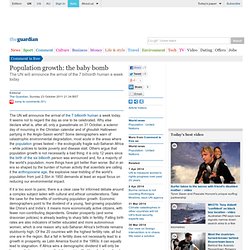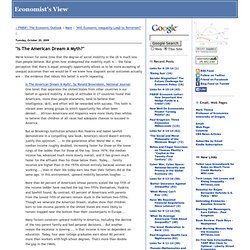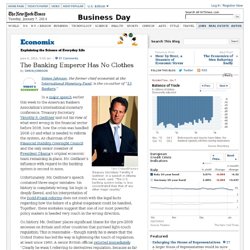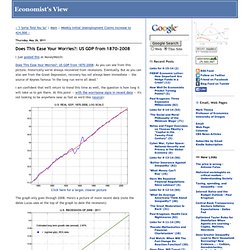

Democracy in the mirror. The Laffer Curve and the Kimel Curve. By Mike Kimel People always talk about the Laffer curve, but have you ever seen it estimated?

Have you ever wondered why you don’t? If you’re a quant guy, you know the answer to that. Because if you’re a quant guy, at some point curiosity must have gotten the best of you. That means you pulled out some data and you plugged it into whatever piece of software happened to be handy. Today, by coincidence, I got two e-mails asking me about the Laffer curve. So here’s how it works. . (1) tax collections / GDP = A + B*tax rate + C*tax rate squared + some other stuff if desired A, B, and C are estimated statistically using a tool such as regression analysis. If you plug in numbers, and find that B is positive and statistically significant and C is negative and statistically significant, then it turns out that you can trace out a quadratic relationship between tax collections / GDP and tax rates. i.e., tax collections / GDP is a function of tax rates that looks like an upside down U.
Population growth: the baby bomb. The UN will announce the arrival of the 7 billionth human a week today.

Civilization. Experimental economics: evolution, methods and achievements. Economist's View: "Is The American Dream A Myth?" We've known for some time that the degree of social mobility in the US is much less than people believe.

But given how widespread the mobility myth is -- the false perception that there is equal (enough) opportunity allows us to be more accepting of unequal outcomes than we would be if we knew how stagnant social outcomes actually are -- the evidence that rebuts this belief is worth repeating: Is The American Dream A Myth? , by Ronald Brownstein, National Journal: One tenet that separates the United States from other countries is our belief in upward mobility. A study of attitudes in 27 countries found that Americans, more than people elsewhere, tend to believe that intelligence, skill, and effort will be rewarded with success. This faith is vibrant even among groups to which opportunity has often been denied:... P2P practices as condition for the next long wave. This article, previously published in Re-public (and written in cooperation with Franz Nahrada and Gleb Tyurin), takes at hypothesis that a new long wave of strong capitalist growth is still in the realm of possibilities.

My own position is that this still can happen, provided strong structural reforms would be undertaken, which is not very likely at this very moment, but could still take place a few years down the road under stronger social pressure. I do not believe however, that humanity has the time for a full Kondratieff wave of 50-60 years, given present danger signs for the biopsphere, and energy and resource depletion generally. In other words, if a there is a uptake of Kondratieff, it is likely to go only half-way before a truly systemic crisis occurs, and humanity has to choose between either regression, or a phase transition to a new political economy.
Mind on Money. Economics has been around for almost four hundred years as a field of study.

For most of its existence, it was known as “political economy.” Glasgow University was the last academic holdout, only changing the name of its department to “Economics” in 1998. Too bad. Or maybe not.
Healthcare. Credit. Immigration. Growth. Dissecting the social. The past dozen years or so have witnessed the emergence of a distinctive approach to the social sciences that its practitioners refer to as "analytical sociology. " Peter Hedström's Dissecting the Social: On the Principles of Analytical Sociology (2005) serves as a manifesto for the approach, and Pierre Demeulenaere, ed., Analytical Sociology and Social Mechanisms , and Peter Hedström and Peter Bearman, eds., The Oxford Handbook of Analytical Sociology provide substantive foundations for several areas of research within this approach.
And the European Network of Analytical Sociologists provides an institutional framework within which research approaches and findings can be shared (link). Hedström describes the analytical sociology approach in these terms: Caballero: Pretense of Knowledge Syndrome. A Thought Experiment: The Boundaries of Neuroeconomics « Cheap Talk. Its a recent development that economists are turning to neuroscience to inform and enrich economic theory.

One controversial aspect is the potential use of neuroscience data to draw conclusions about welfare that go beyond traditional revealed preference. It is nicely summarized by this quote from Camerer, Lowenstein, and Prelec. The foundations of economic theory were constructed assuming that details about the functioning of the brain’s black box would not be known. This pessimism was expressed by William Jevons in 1871:I hesitate to say that men will ever have the means of measuring directly the feelings of the human heart. It is from the quantitative effects of the feelings that we must estimate their comparative amounts.Since feelings were meant to predict behavior but could only be assessed from behavior, economists realized that, without direct measurement, feelings were useless intervening constructs.
Corruption Around the World. In numerous past posts that focused on development, I have stressed that progress can seldom be made when a country is weighed down by corruption.

Corruption is perhaps the single most corrosive factor that keeps developing countries mired in poverty. Corruption also affects developed countries since it unproductively siphons off resources. Each year Transparency International publishes a Corruption Perceptions Index in which it ranks how well or how poorly countries are doing when it comes to eliminating corruption. If you click on the link provided, it will take you to an interactive map and a table that provide a full listing of 178 countries. Economist's View. The Banking Emperor Has No Clothes. Simon Johnson, the former chief economist at the International Monetary Fund, is the co-author of “13 Bankers.”

Tami Chappell/ReutersTreasury Secretary Timothy F. Geithner. in a speech in Atlanta this week, said, “The U.S. banking system today is less concentrated than that of any other major country.” In a major speech earlier this week to the American Bankers Association’s international monetary conference, Treasury Secretary Timothy F. Avant garde economics - macrobusiness.com.au. My esteemed co-blogger Deep T made the comment that too little attention is being paid on MacroBusiness to creative solutions to the problems that are documented in great detail on MacroBusiness. I would go a step further. Economic analysis generally suffers from a deep flaw. Because it is a quasi-science (although in no respect truly scientific) is does not concentrate on what is new and unique. Does This Ease Your Worries?: US GDP from 1870-2008. I just posted this at MoneyWatch: Does This Ease Your Worries?

: US GDP from 1870-2008: As you can see from this picture, historically we've always recovered from recessions. Eventually. The Human Footprint - Friday, April 15, 2011. Humanity’s impact has spread unevenly but everywhere as we have transformed land and sea to meet the demands of a population that has doubled to 7 billion in 40 years.

This map of the human footprint on land shows the combined impact of population density, land transformation, accessibility, and electric-power infrastructure, using nine data sets that researchers scored in terms of estimated contribution to human influence. The corresponding map of the oceans shows the effects of 17 different human activities, such as commercial fishing and pollution from cargo shipping. Both sets of results factored in differences between Earth’s various ecosystems.
Neo-Voodoo Economics - Friday, May 20, 2011. Turner ended with a plea: Mainstream economics needs to embrace the radical notion that people are not rational actors after all. “Good economics leaves us”—policymakers, regulators, and consumers—“with far wider degrees of freedom to make political and social choices than has frequently been asserted,” he told the gathering. “The role of good economics is to inform those choices, not to deny their possibility.”
Good economics is in short supply in the wake of the financial crisis, particularly in Washington—and dangerously so. The period of steady growth that economists once hubristically called the Great Moderation has become the “Great Mortification,” in the words of economic historian Philip Mirowski of the University of Notre Dame. The distrust and disarray among economists have left an intellectual vacuum in Washington’s fiscal and financial debate at a time when the stakes couldn’t be higher. Billy blog » Blog Archive » When a nation stops growing. A lot of readers write to me questioning why I consider economic growth to be important. It is a complex topic and beyond a single blog – especially one that I am writing late this Friday afternoon. Philip Pilkington: Beyond growth – are we entering a new phase of economic maturity? By Philip Pilkington, a journalist and anti-economist writing from amidst the devastated ruins of Dublin, Ireland.
There is Something Very Wrong with This Picture" I've been meaning to highlight this paper by Levy and Kochan, and still hope to do a bit more with it, but for now here's Dani Rodrik: There is something very wrong with this picture, by Dani Rodrik: This graph is from a new paper by Frank Levy and Tom Kochan, showing trends in labor productivity and compensation since 1980: Labor productivity increased by 78 percent between 1980 and 2009, but the median compensation (including fringe benefits) of 35-44 year-old males with high school (and no college) education declined by 10 percent in real terms. Women have done in general better, but two-thirds of women still have seen their pay lag behind productivity.
Eight Facts about Social Security" Sticky prices, leverage, and Pascal’s wager. In Keynesian / quasi-monetarist of explanations of depression, sticky prices play an essential role. If prices were not sticky, a deficiency of expenditure would just lead to a reduction of the price level, and nothing very bad would happen. There are (at least) two channels by which sticky prices can harm production: The Myth of Energy Breakthrough. Renewed belief in the concept of Energy Breakthrough seems resurgent these days, as a versatile scientist now helms the Department of Energy, and famous people such as Bill Gates invoke the need (and thus our quest) for energy miracles. Radioactive Surprise: Desert Oasis Water Traced Back to Nuclear Test Site. June 11, 2010 | Technology Review: Over the Horizon: A Moore's Law for Genetics. Nanofluidic arrays made by BioNanomatrix could make it possible to sequence an individual genome for $100.
The Shape of Things to Come: Understanding the New Global Economy.
As Food Stamp Recipients Hit New Record, 400 Americans Account For 10% Of Capital Gains. Today SNAP released the most recent food stamp numbers. Not surprisingly, we just saw another all time high 44.2 million poverty-level Americans relying on government funding for day to day sustenance. The century of old age - macrobusiness.com.au. As mentioned previously, the 21st century will be the century of old age, where declining birth rates meet longer life expectancies. America’s Middle Class Crisis: The Sobering Facts. Two recessions, a couple of market crashes, and stubbornly high unemployment are all wreaking havoc on America's middle class.
Project Syndicate. Jeremy Has Spoken (But Rest Assured, Pro Money Management Isn't Listening) Op-Ed Contributor - Mr. Soddy’s Ecological Economy. David Sirota: "Barely Squeaking By On $300,000 A Year" Discussions about Energy and Our Future. A Wise Passage. Steve Keen’s Scary Minsky Model. Nihilism Alternatives - Patt 3. Nuclear Powered Desalination. Observational Epidemiology. Think like a methodologist. Economist's View: "Crowding In" A Question of Causality. The misuses of Darwin. Aguanomics. The Automatic Earth. Kimberly Butler: Is the Medium the Message? The Dehumanization of the Medium. Does path dependence prevent real technological progress in energy? The Long Wave Revisited, or Revisionist? The Dooh Nibor Economy (that’s “Robin Hood” backwards!) Corruption, institutions, and firm productivity. Running on Emptiness: The Pathology of Civilization (9780922915750): John Zerzan.
Rethinking the Mall - Opinionator Blog.
ClimateChange. On the End of Money. Clunkernomics Update. Education. HealthCare. More Than Meets the Eye. The Evolution of Foodspotting & its Plans to Expand Beyond Food. Franz Hörmann on the End of Money. 230 mpg? Reinventing Modernity: Reflexive Modernization vs Liquid Modernity vs Multiple Modernities. Ethnography. A perfect dystopian storm: Interview with "Flashmob Gone Wrong" speaker - O'Reilly Radar. The Changing Demographics of America.
Excerpt: Zakaria’s ‘The Post-American World’ - Newsweek. The New Rules: America'sPlace in the World. Bin Laden, Terrorism, and the Economy - CBS MoneyWatch.com. All Together Now (or, Can Collective Intelligence Save the Planet?) - The Sustainability Initiative - MIT Sloan Management Review. The Law Of Unintended "Fair Value Option" Consequences. Inequality and the Right.
The Universe at the End of the Restaurant. Dan Gilbert on our mistaken expectations. Positions In Flux: On The Changing Role Of The Artist And Institution In The Networked Society (Intro) Friday Notebook: The New Simon-Ehrlich Teaching Story.